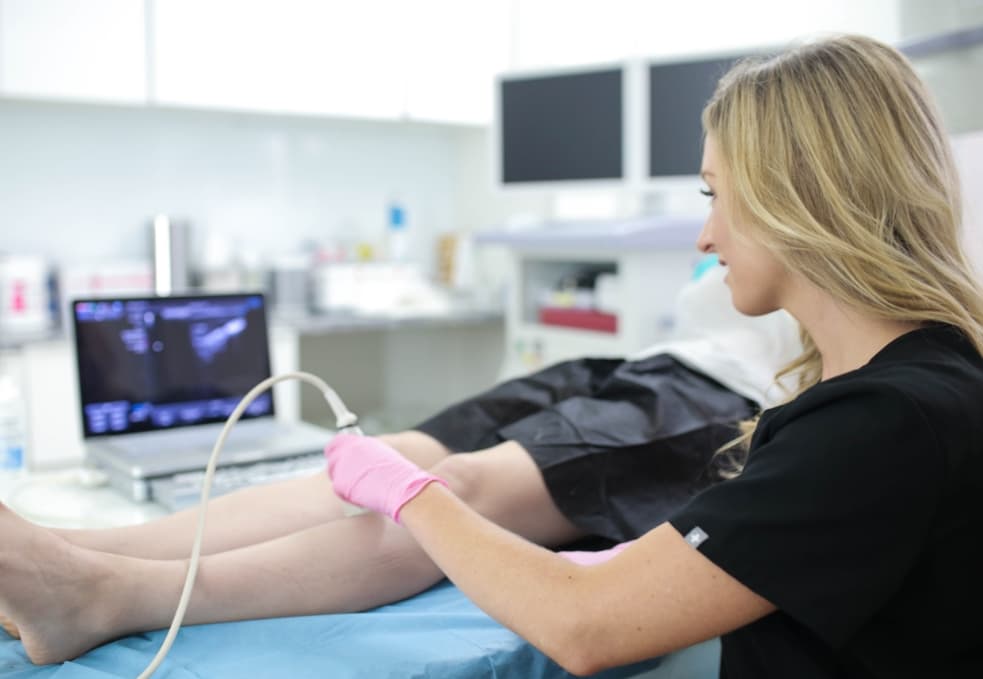Endovenous Ablation: What is it?
Varicose vein ablation is widely considered one of the best minimally invasive treatments for chronic venous insufficiency, the root cause of most vein problems, including spider veins and varicose veins. The endovenous ablation procedure involves inserting a catheter and channels thermal/ laser energy to destroy the diseased vein responsible for your vein problems. This procedure essentially destroys the diseased vein, allowing the accumulated blood to reroute into healthier leg veins. Endovenous ablation restores optimal blood circulation to the heart.
Varicose vein ablation is a minimally invasive treatment, which means it only involves one small incision on the skin’s surface. It’s performed as an in-office and outpatient procedure within the vein doctor’s office, so there’s no need for hospitalization or extended downtime. The vein doctor diagnoses the root cause of your vein problems and performs the vein treatment within an hour, following which you can resume your daily activities and work. Unlike varicose vein surgeries, vein ablation involves minimal risk of side effects or complications.
The Vein Center in Long Island is a group of state-of-the-art vein centers specializing in minimally invasive spider vein and varicose vein treatments. Our vein doctors use cutting-edge duplex ultrasound scans to visualize the blood flow in your leg veins, diagnose vein disease, and curate a personalized vein treatment plan, which may include varicose vein ablation. If you have spider veins, varicose veins, or other signs and symptoms of vein disease, please schedule an appointment at our vein centers in Long Island.

How Does Vein Ablation Treat Vein Disease?
Varicose vein ablation is a minimally invasive treatment for chronic venous insufficiency, the root cause of most vein problems. To understand how vein ablation treats vein disease, you need to understand chronic venous insufficiency.
Venous insufficiency is a medical condition wherein the collapse of vein valves leads to the accumulation of blood in leg veins. Healthy veins contain valves that act as one-way doors, allowing blood to flow towards the heart but not backward. When the vein valves collapse or malfunction, gravity forces blood to flow backward and accumulate in the leg veins, leading to vascular dilation and the eventual formation of spider veins and varicose veins. As such, vein disease is primarily caused by a collapsed vein valve and the accumulation of blood in saphenous veins.
Vein ablation treats chronic venous insufficiency by destroying the diseased saphenous vein responsible for your vein problems. The vein doctor inserts a specialized catheter into the diseased vein under ultrasound guidance. Once in place, the vein doctor activates the catheter to release radiofrequency energy or laser energy and collapse the diseased saphenous vein, rerouting the accumulated blood into healthier leg veins. This procedure restores optimal blood circulation to the heart, and the diseased saphenous vein is eventually metabolized by the body as waste.
Types of Vein Ablation Procedures
Endovenous Radiofrequency Ablation
Endovenous radiofrequency ablation is currently the most popular minimally invasive treatment for chronic venous insufficiency. This procedure involves channeling radiofrequency waves to destroy the diseased saphenous vein and restore optimal blood circulation to the heart. Radiofrequency ablation is a safe and painless procedure that causes minimal post-treatment side effects. The radiofrequency ablation varicose veins recovery time is negligible.
Endovenous Laser Ablation
Endovenous laser ablation pioneered minimally invasive treatments for vein disease back in 2003. This procedure involves inserting a laser fiber channeling laser energy into the diseased vein to make it collapse, rerouting the accumulated blood into healthier leg veins. However, endovenous laser ablation causes more post-treatment pain and discomfort than radiofrequency ablation.
Vein Stripping vs. Ablation
Vein stripping is a surgical procedure that involves hospitalization, multiple excisions, general anesthesia, and weeks of downtime. The vascular surgeon makes a large incision to expose the veins and physically remove the diseased saphenous vein. However, vein stripping involves a high risk of complications, such as infections, and a relatively high risk of vein disease recurrence. That’s why vein stripping is only performed as a last resort if all minimally invasive vein treatments fail to yield results.
Compared to vein stripping, vein ablation is safer, more comfortable, more convenient, and more reliable. Vein ablation has a nearly perfect success rate, and it involves a negligible risk of complications. The procedure is performed within the vein doctor’s office within an hour, following which you can resume most of your daily activities — no general anesthesia or hospitalization. Furthermore, vein ablation also has a lower risk of vein disease recurrence, so you don’t have to worry about chronic venous insufficiency returning.
The Varicose Vein Ablation Procedure
During your varicose vein ablation procedure, the vein doctor will administer local anesthesia to numb your skin’s surface. The vein doctor will make a small incision on the skin’s surface to insert a catheter into the diseased vein under ultrasound guidance. Once the catheter is lodged in place, the vein doctor will administer tumescent anesthesia to protect the surrounding tissues. Finally, the vein doctor will activate the catheter to generate radiofrequency waves and collapse the diseased vein, rerouting the accumulated blood into healthier leg veins. The diseased vein will eventually harden and get absorbed by the body.
How Long Does Vein Ablation Take?
The entire vein ablation procedure may involve two 60-minute sessions. During the first session, the vein doctor will examine your leg veins, review your medical history, perform duplex ultrasound tests, and diagnose chronic venous insufficiency. During the second session, the vein doctor will perform the varicose vein ablation procedure. However, in some cases, the vein doctor can also perform the diagnosis and treatment in one session.

